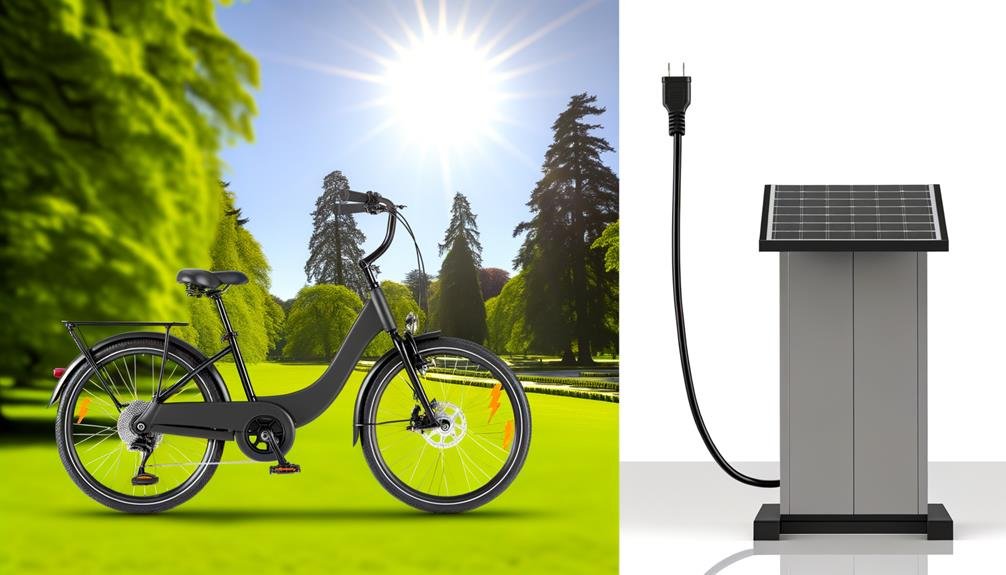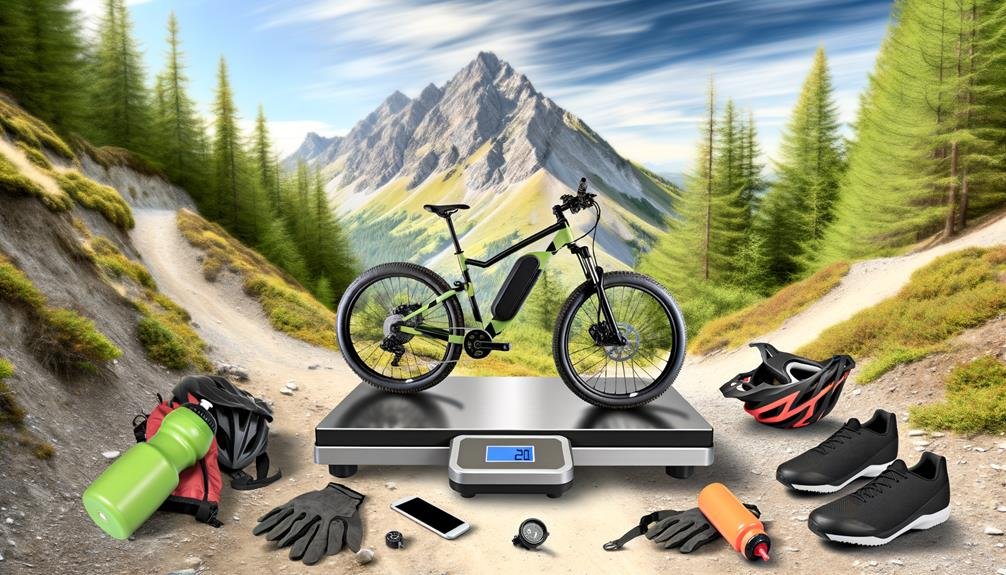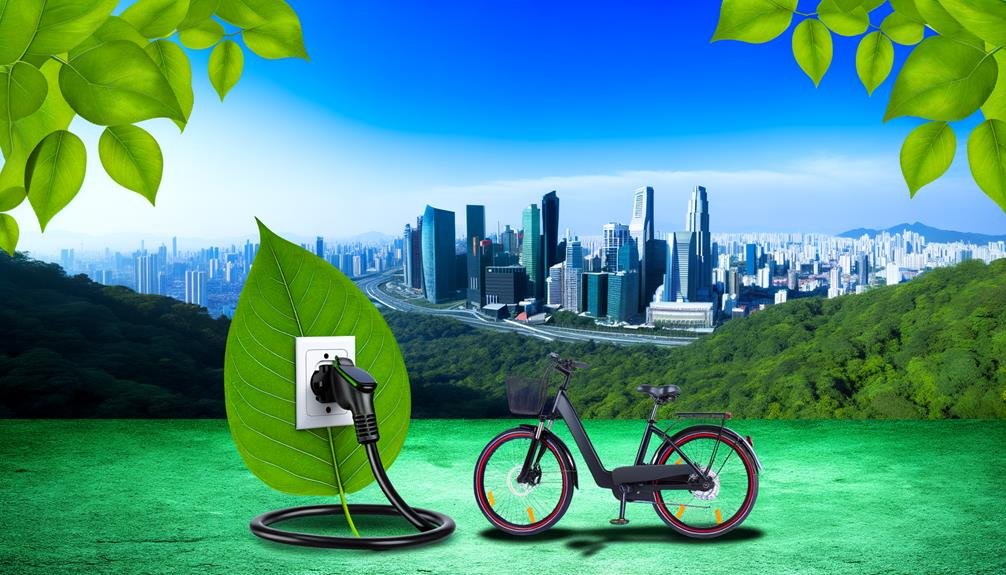Charles Miller is a veteran bike enthusiast with over 12 years of experience dealing with bikes as a mechanic. Despite immense love and expertise for...
Did you know that by 2023, over 40 million electric bikes are expected to be sold worldwide? It's a staggering figure that begs the question: why do these high-tech contraptions still have pedals?
We're here to unlock the mystery behind this seemingly old-school feature on a cutting-edge mode of transport. By the end of our discussion, you'll understand the critical role pedals play in the electric bike's design and functionality, and why they're not likely to disappear anytime soon.
Stick around, there's more to these pedals than meets the eye.
- Key Takeaways
- Understanding Electric Bike Mechanics
- Pedal Assist Functionality
- Throttle Operation on E-Bikes
- Traditional Biking Vs. E-Biking
- The Hierarchy of E-Bike Classes
- Motor and Battery Essentials
- Pedal Assist Vs. Throttle: A Comparison
- E-Bike Range Without Pedaling
- Upgrading Your Travel: E-Bikes Vs. Cars
- Frequently Asked Questions
- Conclusion
Key Takeaways
- Pedals serve as an activator for the motor in electric bikes, allowing riders to convert their own energy into power.
- Pedal assist functionality activates the motor when the rider pedals, providing a smoother and more efficient riding experience on various terrains.
- Pedal assist offers benefits such as effortless cruising, control over speed, and reduced physical exertion, making it ideal for long commutes and fitness routines.
- Throttle operation allows riders to propel the bike without pedaling, but excessive usage can drain the battery faster and may be restricted by local regulations.
Understanding Electric Bike Mechanics
Diving into the heart of electric bike mechanics, it's crucial to understand that the pedals serve not only as a tool for exercise or a backup power source, but also as an activator for the motor in class 1 and class 3 e-bikes. The integration of pedaling into the e-bike system is an ingenious design, allowing riders to convert their own energy into power. This is the essence of understanding electric bike mechanics.
In these e-bikes, the pedal assist function plays a vital part. It enables riders to cycle with the added benefit of motor assistance, providing a smoother and more efficient riding experience. It's like having an invisible hand pushing us forward, making those uphill climbs or long journeys less daunting.
Not all electric bikes, however, have a throttle function. This allows riders to propel the bike without pedaling, much like a motorcycle operates. It's an added feature for those who want a bit more zip in their ride.
Pedal Assist Functionality
Let's turn our attention to the functionality of pedal assist in electric bikes. This feature activates the motor when we pedal, making for an effortless cruise while retaining full control over speed and direction. Whether it's hills, turns, or slight inclines, pedal assist can handle various terrains.
Bikes like Bluejay offer mid-drive torque sensor motors with five levels of assist for easy speed adjustment.
Understanding Pedal Assist
In our exploration of electric bikes, we'll now delve into the intricacies of pedal assist functionality, a feature that activates the bike's motor when the rider pedals, thereby enabling a nearly effortless cruising experience while giving the rider full control over steering and speed.
Pedal assist isn't limited by terrain. It works effectively on hills, turns, and slight inclines, enhancing your riding experience.
These bikes are equipped with mid-drive torque sensor motors. This provides varying levels of assistance, enabling easy speed adjustment.
The transition between traditional pedaling and electric assistance is seamless, thanks to pedal assist functionality.
With pedal assist, you can enjoy the benefits of electric bikes, such as reduced physical exertion and improved health, while contributing to eco-friendly transportation.
Benefits of Pedal Assist
Shifting our focus to the benefits of pedal assist functionality, we find that it not only enhances the overall riding experience by providing effortless cruising and control over speed but also proves beneficial across varied terrains. Pedal assist facilitates smooth rides even on hills, turns, and slight inclines, thus avoiding excessive effort and breathlessness.
| Benefits of Pedal Assist | Description | Example |
|---|---|---|
| Effortless cruising | Facilitates easy rides | Useful on long commutes |
| Control over speed | Speed regulation | Prevents speeding |
| Varied terrains | Works on hills, turns | Great for off-road biking |
| Cost-effective | Economical transportation | Saves on fuel costs |
| Prevents burnout | Avoids excessive physical stress | Ideal for fitness routines |
The pedal assist feature in electric bikes such as Bluejay bikes ensure we're part of an environmentally friendly and exciting biking culture.
Throttle Operation on E-Bikes

Understanding the throttle operation on e-bikes, we see it allows riders to drive the bike forward without pedaling, much like the operation of a motorcycle or scooter. This feature provides a unique dynamic to biking, giving you the freedom to rest while still moving forward. However, it's essential to remember that throttle operation isn't universal on all e-bikes, and its inclusion depends on the specific make and model.
Key aspects to remember about throttle operation on e-bikes include:
- It provides an alternate riding mode, allowing for periods of rest from pedaling.
- Excessive use can drain the e-bike's battery faster, reducing your range.
- Throttle usage while stationary can be dangerous, so it's critical to use caution.
- Local regulations may limit or prohibit throttle use, so awareness of these laws is essential.
These elements highlight the balance between convenience and responsibility that comes with the throttle operation on e-bikes. We must appreciate the innovation, but also understand the implications and obligations that come with it.
Together, we can redefine the biking experience, making it more inclusive and enjoyable for everyone.
Traditional Biking Vs. E-Biking
While comparing traditional biking to e-biking, it's clear that each offers unique advantages, with traditional bikes drawing power solely from human effort, whereas e-bikes integrate an electric motor for assistance, showcasing a significant evolution in biking technology.
In the world of e-biking, it's the pedal-assist and throttle functions that truly distinguish the experience from that of a traditional bike. The pedal-assist eases the effort required to climb inclines and travel longer distances, while the throttle allows the rider to propel forward without pedaling, offering a unique riding experience.
Notably, the flexibility of e-bikes is remarkable; turning off the electric assistance allows riders to relish the traditional biking experience whenever they wish. The effortless cruising, reduced physical exertion, and ability to ride farther and faster are remarkable benefits that e-biking brings to the table.
To evoke a more emotional connection, let's visualize these differences:
| Traditional Bike | E-Bike |
|---|---|
| Solely human-powered | Integrated electric motor |
| Physical exertion required | Reduced physical exertion |
| Limited by human stamina | Longer travel distances |
| No assistance on inclines | Easier inclines with pedal-assist |
| No motor propulsion | Throttle function for propulsion |
E-biking invites us to belong to a community that embraces the evolution of technology in enhancing our biking experiences.
The Hierarchy of E-Bike Classes

Let's now turn our attention to the hierarchy of e-bike classes.
We'll examine the distinct classifications, scrutinize the regulations tied to each class, and outline the benefits unique to each category.
This technical overview will equip us with the knowledge to make an informed decision when choosing an e-bike that fits our needs and complies with local laws.
Understanding E-Bike Classifications
Diving into the realm of e-bikes, we find they're neatly divided into three distinct classes based on their pedal power and top speed capabilities. To bring clarity in understanding e-bike classifications, here's a concise breakdown:
- Class 1: Pedal-assist only with a maximum speed of 20 mph. This class is perfect for the e-bike rider looking for a sweat-free commute.
- Class 2: Equipped with a throttle and can reach 20 mph without pedaling, great for those seeking more comfort and less exertion.
- Class 3: Also pedal-assist, but with a higher speed limit of 28 mph. Ideal for speed enthusiasts.
- Note: E-bikes are classified as such based on legal definitions, but actual performance may vary by model and terrain.
In essence, understanding these classifications can help you choose the e-bike that best fits your needs.
Regulations for E-Bike Classes
Having explored the distinctions between the e-bike classifications, we now turn our attention to the specific regulations for e-bike classes.
These regulations govern the classes, helping you further determine the type of e-bike that won't only meet your needs but also comply with the legal requirements in your area.
Class 1 e-bikes require pedal assistance and have a maximum speed of 20 MPH, while Class 2 e-bikes possess a throttle, allowing speeds up to 20 MPH without pedaling.
Class 3 e-bikes, equipped with speedometers, require pedal assistance and can reach up to 28 MPH.
Benefits of Different Classes
The hierarchy of e-bike classes unfolds a spectrum of benefits, each designed to cater to the specific riding preferences and purposes of diverse users. The question 'why do electric bikes have pedals?' can be answered by understanding the benefits of different classes.
- Class 1 electric bikes offer pedal-assisted riding, promoting physical activity and ensuring a smoother ride.
- Class 2 e-bikes provide the ease of a throttle, enabling cruising without the need for pedaling.
- Class 3 e-bikes enhance pedal-assisted riding, enabling higher speeds and offering a more intense workout.
- Different classes cater to varying preferences and purposes, allowing you to choose the type that best suits your needs.
Each class offers unique advantages, making e-bikes an inclusive and versatile choice for all riders.
Motor and Battery Essentials

Understanding the motor and battery of an electric bike is crucial as they're the heart of power assistance when we're pedaling. These components, undoubtedly, define the performance and longevity of an Electric Bike Without which, the bike would just be another regular bicycle.
The motor, which is often built with a torque sensor, activates with a button press on some bikes, but on others, it requires pedaling. This distinction is important, as some pedaling laws exist. For instance, in the US, the motor's power is limited so it won't push the bike over 20 mph. European laws, on the other hand, mandate pedaling even on bikes equipped with a throttle.
The battery, the powerhouse of assistance, offers adjustable levels of aid. More pedal-assist means reduced range, so it's ideal for tackling steep inclines or hills. To conserve battery life, we can switch off the motor for unassisted rides, though this makes e-bikes heavier than their regular counterparts.
In essence, the motor and battery are the lifeblood of an electric bike, transforming our pedaling efforts into a smooth, effortless ride.
Pedal Assist Vs. Throttle: A Comparison
When comparing pedal assist and throttle e-bikes, it's crucial to note that the former requires the rider's input through pedaling to activate the motor, while the latter can propel forward without any pedaling, functioning more like a motorcycle or scooter. In the discourse of 'Pedal Assist Vs. Throttle: A Comparison', these two types are distinct in their operation.
To create a vivid comparison, consider:
- Pedal assist e-bikes require a level of assistance from the rider. They use a torque sensor to gauge how hard you're pedaling and adjust the motor's output accordingly.
- Throttle e-bikes can power the bike without pedaling, offering a more relaxed ride.
- The level of pedaling required can vary depending on the e-bike's type and the rider's preference.
- E-bikes tend to have both modes, allowing riders to switch between pedal assist and throttle as needed.
We find pedal-assist e-bikes more traditional and suitable for fitness enthusiasts, as they provide power when the rider pedals. Conversely, throttle e-bikes offer a more laid-back experience, perfect for those who prefer a leisurely ride. The choice ultimately depends on your riding style and environment.
E-Bike Range Without Pedaling

Navigating the terrain on an e-bike without pedaling, we find the range typically falls between 20 to 60 miles on a fully charged battery, contingent on factors such as battery capacity, motor power, and the landscape's steepness. Without the need to pedal, you're relying solely on the e-bike's electrical components for movement.
The range is often reduced when carrying a heavy load or climbing hilly terrain. As the battery depletes, the e-bike can still be ridden as a traditional bicycle, providing an essential backup plan for longer journeys.
Using pedal assist mode judiciously can extend the e-bike's range. The power of the motor and the incline of the hill determine the feasibility of riding uphill without pedaling. Throttle e-bikes, for instance, can often be ridden uphill without pedaling, while pedal assist e-bikes usually require some level of pedaling to go uphill.
E-bikes drastically reduce the level of pedaling required compared to traditional bicycles. They provide assistance proportional to the rider's effort, offering a more accessible and inclusive form of cycling. This makes e-bikes an attractive option for those who desire a sense of belonging in the cycling community, without the necessity of extreme physical exertion.
Upgrading Your Travel: E-Bikes Vs. Cars
Pioneering a new era in commuting, we're witnessing how electric bikes, equipped with pedals for alternative propulsion, are increasingly becoming a viable and health-promoting alternative to cars. Not only do they offer an effective way to reduce our carbon footprint, but they also encourage us to be more active, enhancing our overall well-being.
When comparing e-bikes to cars, a few key benefits stand out:
- *Versatility*: Unlike cars, e-bikes can be used as traditional bikes when not utilizing the electric motor, offering flexibility in commuting options.
- *Health benefits*: E-bikes promote physical activity, essentially turning your commute into a workout.
- *Economic efficiency*: Electric bikes are much cheaper to maintain and run than cars.
- *Regulation benefits*: Many areas have regulations favoring bicycles over cars, making the e-bike a more accessible option.
As we delve into the technicalities of e-bikes and their pedals, it's clear that they offer a practical, healthy, and environmentally friendly alternative to traditional motor vehicles.
With such advantages, it's no surprise that we're seeing a growing trend towards electric bike usage in urban commuting.
Frequently Asked Questions
Do Electric Bikes Work Without Pedaling?
Yes, electric bikes can work without pedaling. However, pedaling's not just about necessity; it's also about choice. We're given control to engage physically, enjoy the ride, and extend battery life. It's about balance and flexibility.
Is It Harder to Pedal an Electric Bike?
We've often pondered, is it harder to pedal an electric bike? Actually, it's not. The pedaling resistance isn't significantly different. We can adjust the electric assist to our liking, making the ride comfortable for us.
Can You Manually Pedal an Electric Bike?
Yes, we can manually pedal an electric bike. It's designed for pedaling efficiency, so it's not just an electric vehicle. We belong on the road, whether we're using pedal power or the electric assist.
What Is the Difference Between an E-Bike and an Electric Bike?
We're often asked about the difference between e-bikes and electric bikes. They're actually the same! It's all about e-bike regulations, ensuring they're equipped with pedals for manual use, adhering to speed limits and power restrictions.
Conclusion
In conclusion, we've established the pivotal role pedals play in electric bikes, offering both pedal-assist and throttle operations.
Interestingly, studies reveal that e-bikes can increase cycling speed by up to 15.5 mph, enhancing efficiency significantly.
This, coupled with the ability to switch to traditional biking when needed, makes e-bikes a versatile and efficient mode of transport.
Understanding the mechanics and functionality of e-bikes truly elevates our biking experience, and potentially, our daily commute.

Charles Miller is a veteran bike enthusiast with over 12 years of experience dealing with bikes as a mechanic. Despite immense love and expertise for his Tacoma, he rides his Trek Ebike more. Anytime you meet him, you’ll either hear him talking about Bikes, or writing about all things bikes and cars on this blog.
More Posts


